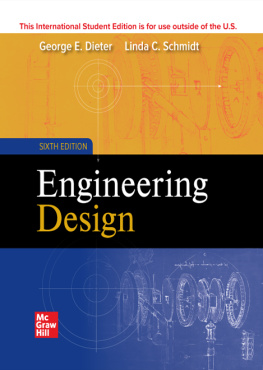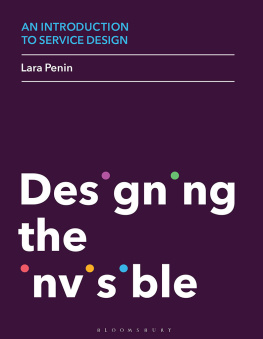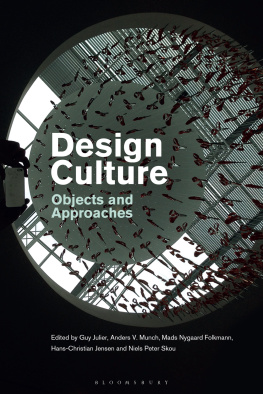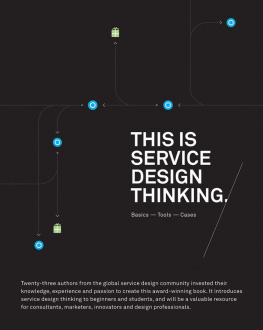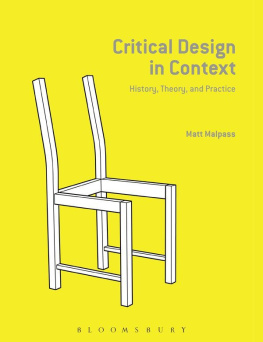
In this wide-ranging book Drazin draws on deep understanding and experience of the multiple contexts in which design operates. By presenting a critical view of the promise and possibilities of design anthropology he offers a manifesto for its role in creating a well-thought human world. A timely and important contribution to the field.
Simon Roberts, Stripe Partners and Board President, EPIC.
Drazin provides an excellent and inspired exploration of the field of design anthropology; accessible to both students and those in related transdisciplinary practice, this book will become a vital reference source.
Professor Alison J. Clarke, University of Applied Arts. Vienna.
We live in a designed world; a world aware of its own designerly preoccupations; a world where design-as-solution-to-something is under conceptualized and all too often unexamined in workaday product and service development. In this comprehensive volume, Adam Drazin, provides a framework for illuminating the work of material culture (the things of design) in social and cultural life and the work of anthropological analysis in effecting change in design concepts and outcomes. Design prototypes are conceptual propositions, Drazin suggests, about relationships among people and things in particular social, cultural, political and temporal contexts. They are good for constituents and designers alike to think with. In creating productive collaborations with constituents, providing sociocultural interpretation of what is going on in the field (everyday life bounded by organizational interests), and using prototypes to think with and through, anthropological work mediates meaning-making between designers and constituencies, so that designed outcomes become ways to assert, subvert, suggest, intervene, frustrate status quos and provoke debate. With great case examples and thoughtful, heuristic approaches to doing the work of collaborative critique, Drazin offers a discipline a way to be on the ground, practicing, navigating, and changing.
Rita Denny, Executive Director, EPIC
(Ethnographic Praxis in Industry Conference).
DESIGN ANTHROPOLOGY IN CONTEXT
This book explores the broad territory of design anthropology, covering key approaches, ways of working and areas of debate and tension. It understands design as fundamentally human centred and argues for a design anthropology based primarily on collaboration and communication. Adam Drazin suggests the most important collaborative knowledges which design anthropology develops are heuristic, emerging as engagements between fieldwork sites and design studios. The chapters draw on material culture literature and include a wide range of examples of different projects and outputs. Highlighting the importance of design as a topic in the study of contemporary culture, this is valuable reading for students and scholars of anthropology and design as well as practitioners.
Adam Drazin is an associate professor at University College London, where he convenes the Studio of Material Life. His other work explores cultures of home and care, the anthropology of Romania and the new materials revolution.
First published 2021
by Routledge
2 Park Square, Milton Park, Abingdon, Oxon OX14 4RN
and by Routledge
52 Vanderbilt Avenue, New York, NY 10017
Routledge is an imprint of the Taylor & Francis Group, an informa business
2021 Adam Drazin
The right of Adam Drazin to be identified as the author of this work has been asserted by him in accordance with Sections 77 and 78 of the Copyright, Designs and Patents Act 1988.
All rights reserved: No part of this book may be reprinted or reproduced or utilised in any form or by any electronic, mechanical or other means, now known or hereafter invented, including photocopying and recording, or in any information storage or retrieval system, without permission in writing from the publishers.
Trademark notice: Product or corporate names may be trademarks or registered trademarks and are used only for identification and explanation without intent to infringe.
British Library Cataloguing-in-Publication Data
A catalogue record for this book is available from the British Library
Library of Congress Cataloging-in-Publication Data
Names: Drazin, Adam, author.
Title: Design anthropology in context : an introduction to design materiality and collaborative thinking / Adam Drazin.
Description: First Edition. | New York : Routledge, 2021. | Includes bibliographical references and index.
Subjects: LCSH: Design--Anthropological aspects. | Design--Human factors.
Classification: LCC NK1520 .D73 2021 (print) | LCC NK1520 (ebook) | DDC 745.4--dc23
LC record available at https://lccn.loc.gov/2020038200
LC ebook record available at https://lccn.loc.gov/2020038201
ISBN: 978-1-138-91798-9 (hbk)
ISBN: 978-1-315-68873-2 (ebk)
Typeset in Bembo
by KnowledgeWorks Global Ltd.
For my grandfathers, Geoffrey Holmes and Isaac Drazin, who worked hard to educate me.
CONTENTS
PART I
Why, what and how?
PART II
Heuristic ways of knowing
Table of Contents
Page List
Landmarks
This book has taken a long time to put together, and there are too many people whom I should thank.
Several people read and commented on drafts of this book, especially Danny Miller and Pauline Garvey. Many of the things I have learned and am trying to pass on I have shamelessly acquired from present and past colleagues. I would like to thank all of my colleagues in the Material Culture section of UCL Anthropology Department, who have given me intellectual and personal support through the writing process. I would like to thank Susanne Kchler, Ludovic Coupaye, Victor Buchli, Chris Tilley, Chris Pinney, Hannah Knox, Jill Reese, Delphine Mercier, Rafael Schacter, Maria alaru, Antonia Walford, Rik Adriaans and Timothy Carroll.
My colleagues from Intel Digital Health Group had a great effect on me, especially Simon Roberts, Tina Basi, David Prendergast and Kyle Kilbourn. Many teachers at various design schools and in design teams have taught me, including David Frohlich, Abi Sellen and Prue Bramwell Davis. Colleagues at the Royal College of Art, Jacques Terken at the Technical University of Eindhoven and the Design Research Group at NCAD Dublin kept me in contact with design ideas. Most importantly, the product designers at Glasgow School of Art taught me how the best design work can be an unrivalled cultural commentary.
I have received a lot of ideas and input from colleagues across Europe and in the European and UK anthropological networks. This includes particularly Alison Clarke, Ton Otto, Thomas Binder, Rachel Charlotte Smith and Mike Anusas.
I would like to particularly thank the dedicated members of the Sligo CLASP Rural Transport, and the unnaturally lively Westmeath Rural Transport Network. They opened my eyes.
My thanks to the editorial team at Taylor and Francis for their patience and understanding about what happens to deadlines when subjected to the pressures of todays demanding UK academic environment, which no longer supports or values research and writing as much as it should do.
My family has been the most patient of all, as I fly weekly between countries: Pauline Garvey, Susannah Drazin, Fionn and Leah. This book would not have been possible without them.



